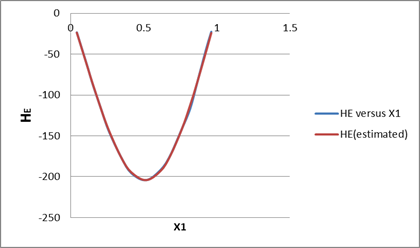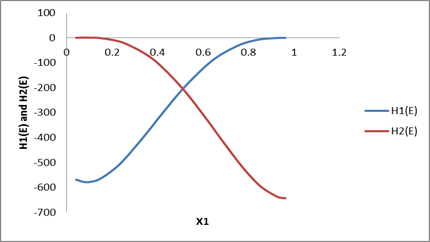
(a)
Interpretation:
Estimation of parameters a, b and c from the given equation and data of composition versus excess enthalpy.
Concept introduction:
Excess molar properties of mixtures are the non ideal nature of real mixtures. They are generally the difference between the partial molar property of a component in a real mixture and in an ideal mixture.
Parameters a, b and c can be determined by fitting the data given in the question.
(a)
Answer to Problem 10.33P
Parameters of the given equations are:
Explanation of Solution
We know that the mole fraction of the second component in a mixture can be written as
Which reduces the given equation of excess volume as:
For calculating parameters using the best fit metod of data to the equation, we must assume initial parameters as:
a = -500 ; b = -100 and c = 0.1
Now we will estimate values of HE using given equation and assumed parameters and find the error using formula given below:
After finding error, we have to minimize the error to best fit the given and estimated data by finding parameter in excel solver as described below:
| x1 | HE(given) | HE(estimated) | Normalized error |
| 0.0426 | -23.3 | -23.2149 | 0.000255 |
| 0.0817 | -45.7 | -45.633 | 0.00011 |
| 0.1177 | -66.5 | -66.6008 | 6.04E-05 |
| 0.151 | -86.6 | -85.833 | 4.78E-05 |
| 0.2107 | -118.2 | -118.781 | 1.08E-06 |
| 0.2624 | -144.6 | -144.559 | 5.81E-05 |
| 0.3472 | -176.6 | -178.669 | 9.94E-07 |
| 0.4158 | -195.7 | -196.933 | 2.64E-05 |
| 0.5163 | -204.2 | -206.209 | 1.4E-08 |
| 0.6156 | -191.7 | -193.963 | 4.17E-05 |
| 0.681 | -174.1 | -174.738 | 1.05E-05 |
| 0.7621 | -141 | -140.126 | 3.45E-06 |
| 0.8181 | -116.8 | -110.579 | 0.001453 |
| 0.865 | -85.6 | -83.2654 | 1.4E-05 |
| 0.9276 | -43.5 | -44.7103 | 0.004488 |
| 0.9624 | -22.6 | -23.0104 | 0.004457 |
| Sum of error | 0.011027 | ||
| Estimated | Assumed | ||
| a | -530 | -500 | |
| b | -1129 | -100 | |
| c | 1050 | 0.1 |

By the linear fitting of the given data in the given equation, we will get parameters as:
(b)
Interpretation:
Estimation the minimum value of excess enthalpy and composition at which it becomes minimum.
Concept introduction:
Excess molar properties of mixtures are the non ideal nature of real mixtures. They are generally the difference between the partial molar property of a component in a real mixture and in an ideal mixture.
(b)
Answer to Problem 10.33P
Minimum value of excess enthalpy = -204.4 J/mol at composition 0.512.
Explanation of Solution
We know that the mole fraction of the second component in a mixture can be written as
Which reduces the given equation of excess enthalpy as:
Put the determined parameter values from part (a) to the equation (1), we get:
Now differentiate above equation with respect to x1 and equate it to zero gives:
Now we will find the value of x1 which satisfies the above equation:
Let x1 = 0.5
Near to zero, so composition will be approximately 0.5 or 0.513.
So, at x1 = 0.513 excess enthalpy will be a minumum and the minimum value of excess enthalpy can be calculated as given below:
(c)
Interpretation:
Derive expression for
Concept introduction:
Excess molar properties of mixtures are the non ideal nature of real mixtures. They are generally the difference between the partial molar property of a component in a real mixture and in an ideal mixture.
Partial molar properties can be derived from equations:
(c)
Answer to Problem 10.33P
Expression of partial molar properties is:
The graph plotted between partial molar properties and composition.
Explanation of Solution
We know that the mole fraction of the second component in a mixture can be written as
Which reduces the given equation of excess enthalpy as:
Put the determined parameter values from part (a) to the equation (1), we get:
Now differentiate the above equation with respect to x1 and get:
The expression for partial molar enthalpy can be written as follows:
Plot of partial molar properties derived above with x1 can be drawn as follows:
We know that,
So, the partial molar equations become:
| x1 | HE | H1(E ) | H2(E ) |
| 0.0426 | -23.3 | -568.736 | 0.760504 |
| 0.0817 | -45.7 | -584.771 | 1.762019 |
| 0.1177 | -66.5 | -585.497 | 1.796789 |
| 0.151 | -86.6 | -576.017 | 0.291058 |
| 0.2107 | -118.2 | -539.462 | -7.96384 |
| 0.2624 | -144.6 | -492.7 | -22.5599 |
| 0.3472 | -176.6 | -398.129 | -64.4174 |
| 0.4158 | -195.7 | -315.445 | -115.569 |
| 0.5163 | -204.2 | -200.304 | -216.279 |
| 0.6156 | -191.7 | -107.319 | -337.296 |
| 0.681 | -174.1 | -61.7537 | -421.072 |
| 0.7621 | -141 | -23.8448 | -518.49 |
| 0.8181 | -116.8 | -8.90102 | -574.265 |
| 0.865 | -85.6 | -2.30111 | -608.877 |
| 0.9276 | -43.5 | 0.450114 | -630.781 |
| 0.9624 | -22.6 | 0.303215 | -627.571 |
Plot drawn according to data calculated in the above table as:

Want to see more full solutions like this?
Chapter 10 Solutions
INTRO.TO CHEM.ENGR.THERMO.-EBOOK>I<
- Untuk sistem gas etilena (1)/propilena (2), estimasi (f^1, f^2, $^1, dan ^2 pada t = 150°C, P = 30 bar, dan y1 = 0,35; kij = 0. (a) Dengan menerapkan Persamaan (10.63). (b) Dengan asumsi bahwa campuran adalah lingkungan idealarrow_forwardOnly focus on H(3), which is the specific enthalpy for nitrogen gas. chemical engineeringarrow_forwardchemical engineering. Only focus on H(3), which is the nitrogen gas. Start with the reference state to the process state. Be thorough to the fullestarrow_forward
- acetone with these parameters: po:=101325; #Standard atmospheric pressure in PaTfo:=273.15-94.45; #Melting temperature in K Tvo:=273.15+56.15; #Boiling temperature in K Hv:=31270; #Enthalpy of vaporization in J/molR:=8.314; #Gas Constant in J/mol*KNLe:=1.76; #Lewis number for acetoneMw:= 0.05808 ; #kg/mol molecular weight of acetoneW0:= 0.15; Wsp:=0.005;Am:= 0.12; #m^2/kg dry solid for the exposed wet areah:= 11; #W/m^2K for heat transfer coefficienttau__min:= Hv*(W0-Wsp)/Mw/Am/h/(T8-TS); tau__min/60;arrow_forwardchemical engineering Material-energy balance. Only focus on the nitrogen gas, which is H(3)arrow_forward1. The settling chamber, shown schematically in Figure 2E1.1, is used as a primary separation device in the removal of dust particles of density 1500 kg/m³ from a gas of density 0:7 kg/m³ and viscosity 1.90 x 10-5 Pa s. Gas inlet Elevation Gas Gas exit exit H Collection surface -W Section X-X Dimensions: H=3m L = 10 m W=2m Figure 2E1.1 Schematic diagram of settling chamber Assuming Stokes' law applies, show that the efficiency of collection of particles of size x is given by the expression collection efficiency, x = x²8(pp - Pi)L 18μHU where U is the uniform gas velocity through the parallel-sided section of the chamber. State any other assumptions made. (b) What is the upper limit of particle size for which Stokes' law applies? (c) When the volumetric flow rate of gas is 0.9 m³/s, and the dimensions of the chamber are those shown in Figure 2E1.1, determine the collection efficiency for spherical particles of diameter 30 mm.arrow_forward
- Can you answer this sequantially correct like show me the full process. Also, since it is chemical engineering related problem a perry's handbook is used. Thank youarrow_forwardchemical engineering Demonstrate how each specific enthalpy was calculated, from the reference state to the process state. Be thorough to the fullest. This is a material-energy balance. The answers are H(1) = 35.7 KJ/kmol, H(2) = 32.0 KJ/kmol, and H(3) = -1.26 KJ/kmol.arrow_forwardheat and mass transfer:arrow_forward
- Chemical Engineering. Be thorough to the fullest for the three enthalpies. H(1) = 35.7 kj/kmol H(2) =32.0 Kj/kmol H(3)= -1.26 Kj/kmolarrow_forwardchemical engineering Only solve the specific enthalpies. Be thorough to the fullest for each calculationarrow_forwardDo question 9 please! Question 7 Is just there for reference!!arrow_forward
 Introduction to Chemical Engineering Thermodynami...Chemical EngineeringISBN:9781259696527Author:J.M. Smith Termodinamica en ingenieria quimica, Hendrick C Van Ness, Michael Abbott, Mark SwihartPublisher:McGraw-Hill Education
Introduction to Chemical Engineering Thermodynami...Chemical EngineeringISBN:9781259696527Author:J.M. Smith Termodinamica en ingenieria quimica, Hendrick C Van Ness, Michael Abbott, Mark SwihartPublisher:McGraw-Hill Education Elementary Principles of Chemical Processes, Bind...Chemical EngineeringISBN:9781118431221Author:Richard M. Felder, Ronald W. Rousseau, Lisa G. BullardPublisher:WILEY
Elementary Principles of Chemical Processes, Bind...Chemical EngineeringISBN:9781118431221Author:Richard M. Felder, Ronald W. Rousseau, Lisa G. BullardPublisher:WILEY Elements of Chemical Reaction Engineering (5th Ed...Chemical EngineeringISBN:9780133887518Author:H. Scott FoglerPublisher:Prentice Hall
Elements of Chemical Reaction Engineering (5th Ed...Chemical EngineeringISBN:9780133887518Author:H. Scott FoglerPublisher:Prentice Hall
 Industrial Plastics: Theory and ApplicationsChemical EngineeringISBN:9781285061238Author:Lokensgard, ErikPublisher:Delmar Cengage Learning
Industrial Plastics: Theory and ApplicationsChemical EngineeringISBN:9781285061238Author:Lokensgard, ErikPublisher:Delmar Cengage Learning Unit Operations of Chemical EngineeringChemical EngineeringISBN:9780072848236Author:Warren McCabe, Julian C. Smith, Peter HarriottPublisher:McGraw-Hill Companies, The
Unit Operations of Chemical EngineeringChemical EngineeringISBN:9780072848236Author:Warren McCabe, Julian C. Smith, Peter HarriottPublisher:McGraw-Hill Companies, The





